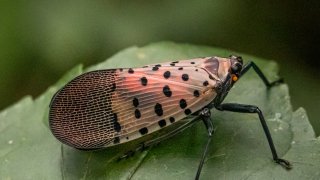
The Natural Resources Commission is asking residents in Wellesley, Massachusetts to report infestations of the spotted lanternflies.
The spotted lanternflies are an invasive species that attacks plants.
Wellesley received word this week from the Massachusetts Department of Agricultural Resources (MDAR) of an infestation near Carisbrooke Reservation.
Spotted lanternflies (Lycorma delicatula or “SLF”), while not new to the Bay State, are being found in more communities across the Commonwealth. Worcester became the fourth to identify an infestation of them in September.
Some places in the country, like New Jersey, which advertises joining the "Stomp Team", and New York City, have asked residents to kill spotted lanternflies whenever they see the insects.
In Massachusetts, 33 communities have spotted lanternfly sightings since 2018, and of the state's four local infestations -- in Fitchburg, Springfield, Shrewsbury and Worcester -- three came this year.
Spotted lanternflies are around the size of a quarter, grey with black spots and have wings that are red underneath -- that part is visible when they fly. They're larger than many other insects in Massachusetts.
U.S. & World
The spotted lanternfly feeds on plant sap, Orth said. Its straw-shaped mouth "causes a lot of damage to certain plants, particularly grapes, which is one of the reasons we’re concerned both for wild grapes here in Massachusetts and also for grape growers and vineyards here in the state."
In addition to grapes, spotted lanternflies threaten maple trees, hops, blueberries and over 100 other host plants, according to the Department of Agricultural Resources.
Not only can their feeding be harmful to plants, Orth explained, but a "sticky, sugary waste product" the insects excrete can also cause harm when there's an infestation.
"The 'honeydew' coats everything below where the lanternflies are," she said. "So it gets all over tree trunks and shrubs and grass and your porch, your car. And then it's all sticky and sugary, so it starts to ferment and it grows this fungus...that not only damages any plants that it coats, but it smells really bad and it can be a pain to deal with."
Orth said the insect originated in Asia and first appeared in the United States in 2014 in Pennsylvania. Spotted lanternflies were believed to have made their way there via a shipment of crushed stone and continue to hitchhike to other regions.
"We know that they are associated with the transportation industry, so we’ve seen spotted lanternflies come in on vehicles, cars, trucks -- also through railway transport," Orth said. "We’ve also seen them come in on shipments of things like pumpkins and mums and things that come in in the fall when adults are active from other states."
The first report of these insects in Massachusetts was in 2018, when a dead spotted lanternfly was discovered in a poinsettia plant, according to Orth.
You can learn more about the spotted lanternfly and report any sightings here.



